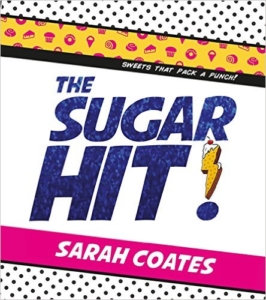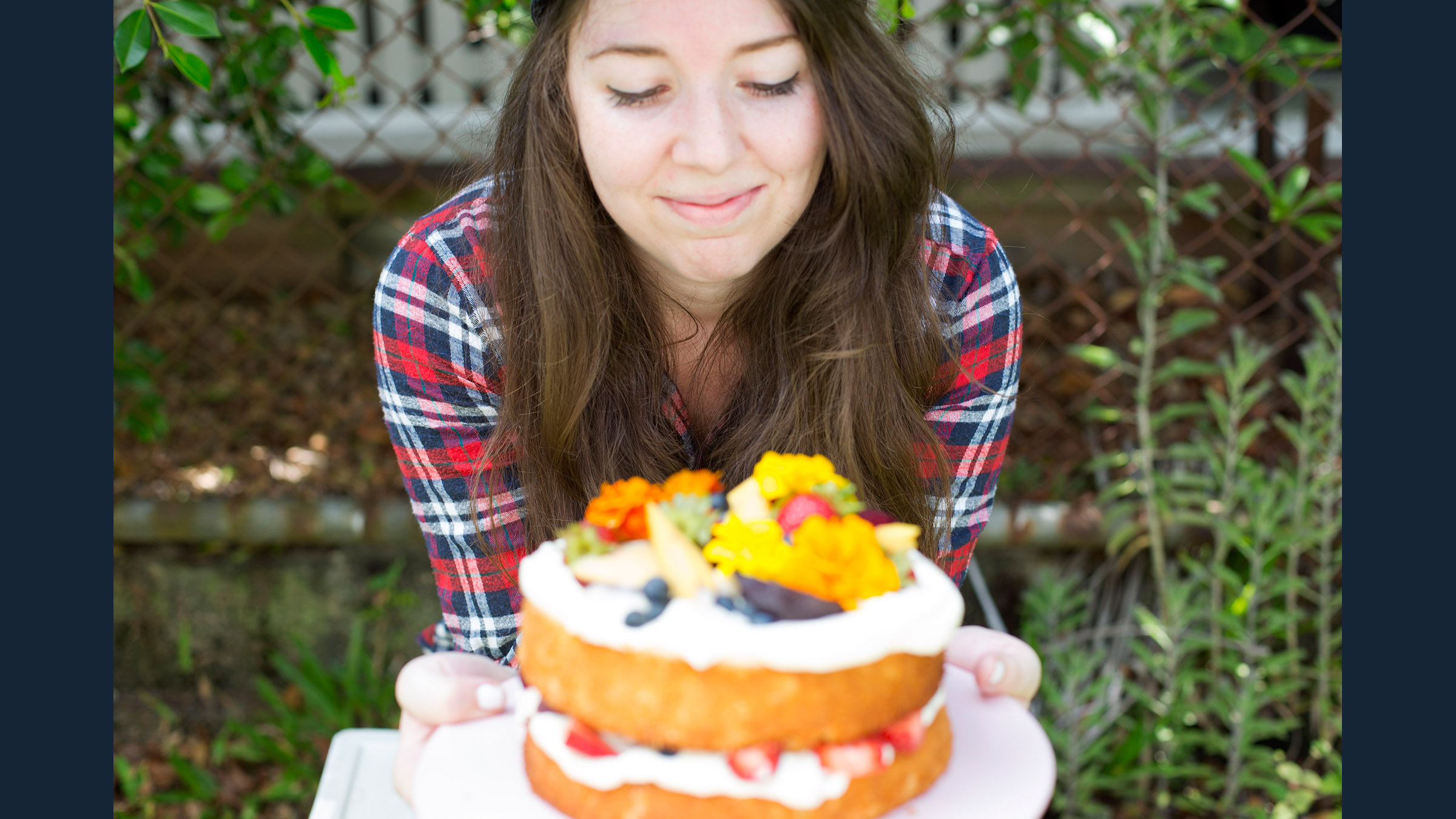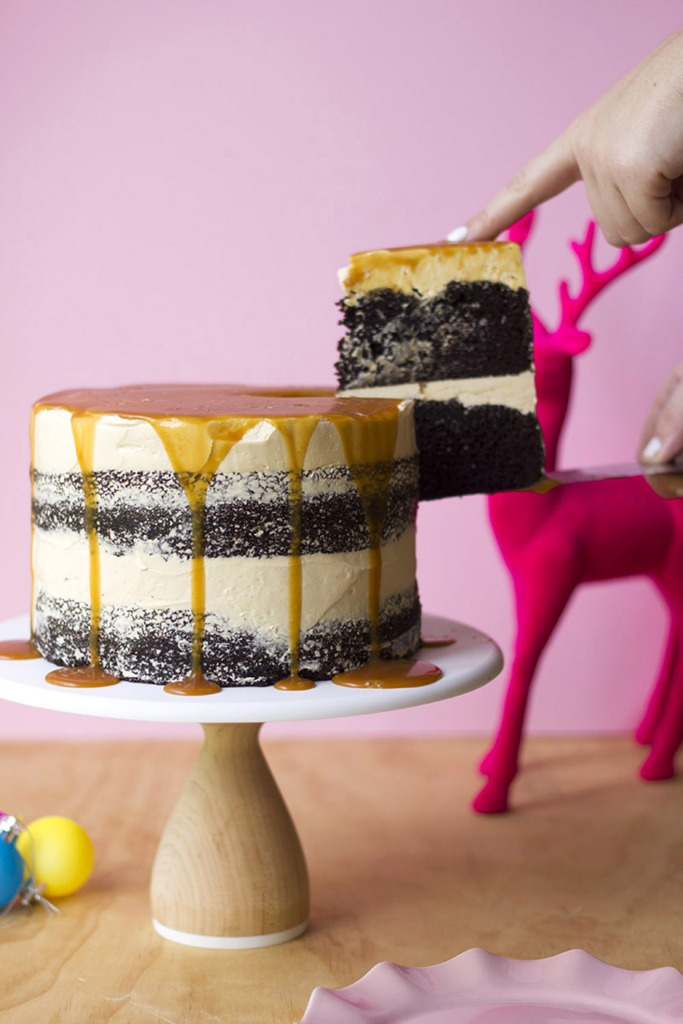Rich, cocoa-dark layers of buttermilk chocolate cake, slathered with salted caramel buttercream, and a drizzle of yet more smoky caramel.
Smoky Salted Caramel Chocolate Layer Cake
– Recipe by Sarah Coates, adapted from Call Me Cupcake
Serves: 1 x 7 inch cake
Ingredients:
For the cakes
1 + ¾ cups (265g) all purpose flour
1 + ½ cups (300g) caster sugar
½ cup (110g) brown sugar
¾ cup (70g) cocoa powder
2 tsp instant espresso powder
2 tsp baking soda (bicarb)
1 tsp baking powder
pinch of salt
1 cup (250ml) buttermilk
½ cup flavourless oil (I use grapeseed)
2 eggs
2 tsp vanilla bean paste (or extract)
1 cup (250ml) hot water
For the caramel
3 tbsp water
1 cup (200g) caster sugar
1 stick (115g) butter
¾ cup (185ml) heavy cream (aka thickened cream)
1 tsp smoked sea salt
For the buttercream
4 egg whites
1 cup, minus 2 tbsp (180g) caster sugar
2 sticks + 1 tbsp (250g) butter, very soft
½ cup smoky salted caramel (above)
Method:
1. First make the cakes. Grease and line two 7-inch (18cm) cake tins, and preheat the oven to 350F/170C, no fan.
2. Place all the dry ingredients for the cake (everything from flour to salt) into a very large mixing bowl, and stir very vigorously with a whisk to get out any lumps.
3. In a large measuring jug, whisk together the buttermilk, oil, eggs and vanilla, then stir into the dry ingredients. Finally pour the hot water into the mix, and stir until everything is smooth and combined. The batter is fairly liquid – like thick custard.
4. Divide the batter evenly between the two cake tins, and bake for 35-40 minutes, or until springing back when touched in the centre, and a skewer comes out with only a few moist crumbs. Place the cakes in their tins on a wire rack, and leave to cool completely.
5. Meanwhile, make the caramel. Place the water into a large, heavy based saucepan, and then pour the sugar into the centre of the pan, making sure it is moistened by the water.
6. Place the pan over a medium-high heat, and cook without stirring until the sugar melts and begins to bubble. You can gently tip and swirl the pan if the sugar is not melting evenly. Continue to cook the sugar for about 5-8 minutes, or until it turns a dark golden amber colour.
7. Remove the pan from the heat, and very carefully add in the butter and cream. The caramel will bubble up a lot, and hiss steam. But just carefully stir until everything melts and settles down.
8. Place the caramel back on the heat, just for 20 seconds or so, stirring to make sure everything is melted. Remove from the heat, add in the salt, and then pour into a jar or bowl and leave to cool completely.
9. To make the buttercream, place the egg whites and sugar into a large bowl, and stir them with a whisk, just gently, to combine. Place the bowl over a pan of simmering water – the water should not touch the bowl – and whisk slowly until the mixture reaches 65C/145F. If you don’t have a thermometer, you can test by rubbing some of the mixture between your fingers. When you can’t feel any sugar granules, and the mixture is hot (not boiling hot, but just hot) to the touch, it’s ready.
10. Remove the mixture from the heat, and place into the bowl of a stand mixer, fitted with the whisk attachment. Whisk the mixture on a medium high speed, until it triples in volume, becomes white and voluminous, and cools down completely – about 7-10 mins.
11. When the mixture is cool, begin adding the butter, about 1 tbsp at a time, whisking for 20 seconds or so, between pieces. Keep going until all the butter is in. At some point, the mix may begin to look very liquid and soupy – don’t worry, just keep whisking and I promise it will come together in a smooth shiny frosting. Just keep whisking!
12. When all the butter is in, and you have a thick cloud of frosting, finally, whisk in ½ cup of the cooled caramel. If the frosting is a little soft, chill it in the fridge for 15-20 minutes to firm it up.
13. To assemble the cake, trim the layers if they are domed, and place one of the layers onto a cake stand. Top with half the buttercream, and spread into an even layer, right to the edge of the cake.
14. Top with the second layer, and press down gently, but firmly and evenly, sinking it into the frosting just slightly and making it bulge out the sides. Top with the remaining half of the frosting and again spread into an even layer, right to the edge of the cake, and let it overhang the edge a little bit, too.
15. Now, take a palette knife and smooth the frosting that is overhanging the layers all over and around the cake creating a very thin, smooth coating all over the cake. Place the palette knife vertically against the edge of the top layer of frosting, and smoothly drag it around the cake, to create a flat wall of frosting. Then, working from the outside in, smooth out the top of the frosting, to create a flat layer. Once the cake is coated, and everything is at straight and flat as you can get it, place in the fridge to chill for at least half an hour.
16. When the cake is completely chilled, pour over about half a cup of the remaining caramel (you will have a little left over) and spread gently to the edge of the cake, allowing it to drip down the sides in a few places. Sprinkle a little extra salt on top, if desired, and serve!
 About The Sugar Hit!
About The Sugar Hit!
Brisbane-based blogger Sarah Coates has been a cook since she was able to sit up without assistance, at which point she was handed a child’s knife and a potato to hack away at. She started The Sugar Hit! in 2010 as “a resource for the young, the broke, the hungry, and anyone who just wants to eat.” After she said goodbye to her desk job in 2012, the blog grew into an award-winning resource for food lovers. Her book by the same title came out in 2015. Visit The Sugar Hit! and her book on Amazon.com.
Click here for more delicious cake-related recipes from the world’s top pastry bloggers.















Sorry, the comment form is closed at this time.